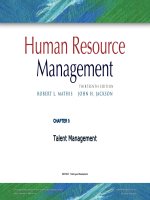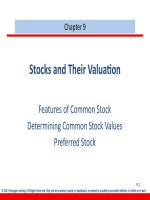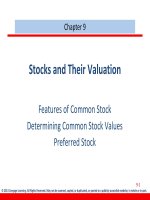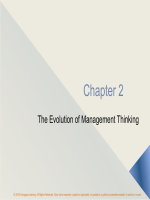Management 12e richard draft chapter 09
Bạn đang xem bản rút gọn của tài liệu. Xem và tải ngay bản đầy đủ của tài liệu tại đây (351.63 KB, 19 trang )
Chapter 9
Managerial Decision Making
© 2016 Cengage Learning. All Rights Reserved. May not be scanned, copied or duplicated, or posted to a publicly accessible website, in whole or in part.
Types of Decisions
and Problems
Decision
making is the
process of
identifying
opportunities
Decision is a
choice made
from available
alternatives
© 2016 Cengage Learning. All Rights Reserved. May not be scanned, copied or duplicated, or posted to a publicly accessible website, in whole or in part.
2
Programmed and
Nonprogrammed Decisions
Programmed Decisions
Recurring problems
Apply rule
Nonprogrammed Decisions
Unique situations
Poorly defined
Unstructured
Important consequences
© 2016 Cengage Learning. All Rights Reserved. May not be scanned, copied or duplicated, or posted to a publicly accessible website, in whole or in part.
3
Facing Certainty
and Uncertainty
Difference between programmed and
unprogrammed decisions
Certainty – Situation in which all information is
fully available
Risk – Future outcomes associated with an
alternative are subject to chance
Uncertainty - Depends on the amount and
value of information available
© 2016 Cengage Learning. All Rights Reserved. May not be scanned, copied or duplicated, or posted to a publicly accessible website, in whole or in part.
4
9.1 Conditions that Affect the
Possibility of Decision Failure
© 2016 Cengage Learning. All Rights Reserved. May not be scanned, copied or duplicated, or posted to a publicly accessible website, in whole or in part.
5
Ambiguity and Conflict
Ambiguity - Making decisions in difficult
situations
The goals and the problem are unclear
Wicked decisions involve conflict over goals and
have changing circumstances, fuzzy
information, and unclear links
There is often no “right” answer
© 2016 Cengage Learning. All Rights Reserved. May not be scanned, copied or duplicated, or posted to a publicly accessible website, in whole or in part.
6
The Ideal, Rational Model
Rational economic assumptions drive decisions
Operates to accomplish established goals, problem is
defined
Decision maker strives for information and certainty,
alternatives evaluated
Criteria for evaluating alternatives is known; select
alternative with maximum benefit
Decision maker is rationale and uses logic
Normative─ how a decision maker should make
a decision
© 2016 Cengage Learning. All Rights Reserved. May not be scanned, copied or duplicated, or posted to a publicly accessible website, in whole or in part.
7
How Managers Actually
Make Decisions
Administrative/descriptive approach
How managers really make decisions
Recognize human and environmental limitations
Bounded rationality – People have limits or
boundaries on how rational they can be
Satisficing – Decision makers choose the first
solution that satisfies minimal decision criteria
© 2016 Cengage Learning. All Rights Reserved. May not be scanned, copied or duplicated, or posted to a publicly accessible website, in whole or in part.
8
Steps in the Administrative
Model
Goals are often vague
Rational procedures are not always used
Managers’ searches for alternatives are limited
Most managers settle for satisficing
Intuition – Quick apprehension of situation
based on practice and experience
© 2016 Cengage Learning. All Rights Reserved. May not be scanned, copied or duplicated, or posted to a publicly accessible website, in whole or in part.
9
Decision-Making Model:
Political
Decisions involve managers with diverse
interests
Managers must engage in coalition building
Informal alliance to support specific goal
Without a coalition, powerful groups can derail
the decision-making process
Political model resembles the real environment
© 2016 Cengage Learning. All Rights Reserved. May not be scanned, copied or duplicated, or posted to a publicly accessible website, in whole or in part.
10
Decision-Making Model:
Political
Assumptions of the political model
Organizations are made up of groups with
diverse interests, goals, and values
Information is ambiguous and incomplete
Lack of time, resources, or mental capacity to
process all information regarding a problem
Decisions are the result of bargaining and
discussion among coalition members
© 2016 Cengage Learning. All Rights Reserved. May not be scanned, copied or duplicated, or posted to a publicly accessible website, in whole or in part.
11
9.2 Characteristics of Classical,
Administrative, and Political Decision-Making
Models
© 2016 Cengage Learning. All Rights Reserved. May not be scanned, copied or duplicated, or posted to a publicly accessible website, in whole or in part.
12
Decision-Making Steps
Recognition of Decision Requirement – Identify problem or
opportunity
Diagnosis and Analysis – Analyze underlying causal factors
Develop Alternatives – Define feasible alternatives
Selection of Desired Alternative – Alternative with most desirable
outcome
Implementation of Chosen Alternative – Use of managerial,
administrative, and persuasive abilities to execute chosen alternative
Evaluation and Feedback – Gather information about effectiveness
© 2016 Cengage Learning. All Rights Reserved. May not be scanned, copied or duplicated, or posted to a publicly accessible website, in whole or in part.
13
9.3 Six Steps in the Managerial
Decision-Making Process
© 2016 Cengage Learning. All Rights Reserved. May not be scanned, copied or duplicated, or posted to a publicly accessible website, in whole or in part.
14
9.4 Decision Alternatives
with Different Levels of Risk
© 2016 Cengage Learning. All Rights Reserved. May not be scanned, copied or duplicated, or posted to a publicly accessible website, in whole or in part.
15
9.5 Personal Decision
Framework
© 2016 Cengage Learning. All Rights Reserved. May not be scanned, copied or duplicated, or posted to a publicly accessible website, in whole or in part.
16
Personal Decision Framework
Directive style – People who prefer simple,
clear-cut solutions to problems
Analytic style – Managers prefer complex
solutions based on a lot of data
Conceptual style – Managers like a broad
amount of information
Behavioral style – Managers with a deep
concern for others
© 2016 Cengage Learning. All Rights Reserved. May not be scanned, copied or duplicated, or posted to a publicly accessible website, in whole or in part.
17
Why Do Managers Make
Bad Decisions?
Being influenced by initial impressions
Justifying past decisions
Seeing what you want to see
Perpetuating the status quo
Being influenced by problem framing
Overconfidence
© 2016 Cengage Learning. All Rights Reserved. May not be scanned, copied or duplicated, or posted to a publicly accessible website, in whole or in part.
18
Innovative Decision Making
Mechanisms to help reduce bias-related
decision errors:
Start with brainstorming
Use hard evidence
Engage in rigorous debate
Avoid groupthink
Know when to bail
Do a postmortem
© 2016 Cengage Learning. All Rights Reserved. May not be scanned, copied or duplicated, or posted to a publicly accessible website, in whole or in part.
19









